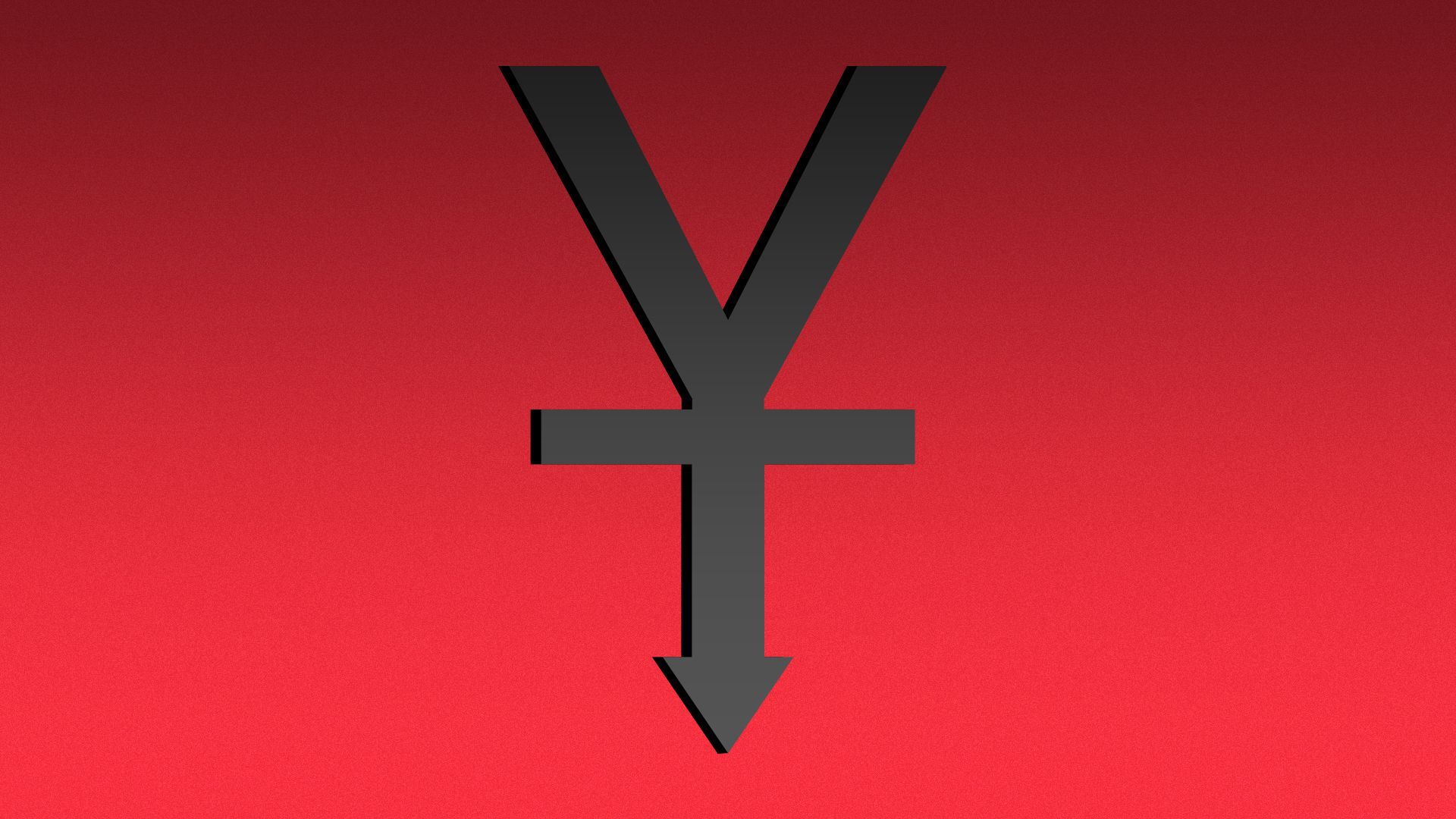| | | | | | | Presented By Ripple | | | | Axios Markets | | By Matt Phillips and Emily Peck · Apr 19, 2022 | | 👋 Oh, hi. Glad you're back. There's much to discuss. Matt's digging in on China. There's a natural gas chart, too. Bonus: We remain a poison-pill-free zone. You can proceed without fear. Let's do this! Today's newsletter is 972 words, 4 minutes. | | | | | | 1 big thing: China economy is sputtering |  | | | Illustration: Shoshana Gordon/Axios | | | | The largest single driver of global economic growth — China — is stalling as its "zero COVID" policy collides with a massive virus outbreak and large-scale lockdowns, Matt writes. Why it matters: We're all focusing on inflation and the war in Ukraine, but the path of the world economy and global financial markets this year largely hinges on China's economic and public health. Driving the news: A slew of Chinese economic data out Monday confirmed that the world's second-largest economy has sputtered as the government combats the worst outbreak of COVID so far on the mainland. - Retail sales tumbled 2% during the month. Compared to March 2021, retail sales were down 3.5%, the worst annual drop since 2020.
- The country's unemployment rate rose to 5.8%, above the government's target of 5.5% and the worst since May 2020, when the country was first emerging from lockdowns after the initial virus outbreak in Wuhan.
- Industrial production slowed sharply in March, as did investment in the domestic real estate sector, which has been a key driver of the country's growth.
State of play: China is in the middle of its worst known outbreak of the coronavirus since the pandemic began in early 2020. The surge in cases, which more than doubled over the last month, has prompted a range of lockdowns. - They include a hard lockdown in late March in Shanghai, the country's richest and largest urban area.
- Other major cities such as electronics manufacturing center Shenzhen, and port and petrochemical hub Tianjin have also been disrupted.
- J.P.Morgan analysts currently estimate that "areas with full or partial lockdowns accounted for about 25%" of gross domestic product, according to a recent research note.
Yes, but: Official data released Monday showed China's GDP grew a faster-than-expected 4.8% in the first quarter — though that's far slower than the breakneck pace above 10% that prevailed between 2000 and 2010. Yes, but, but: Some analysts view the GDP numbers suspiciously, given how focused Chinese government officials are on meeting growth targets. Our thought bubble: China's woes will quickly become the world's problem. - As it remains an export giant and a crucial cog in global supply chains, Chinese factory shutdowns and logistical disruptions will amplify the already-problematic global price pressures.
What we're watching: The International Monetary Fund's update on the outlook for the global economy — due to be released in a couple of hours — could spell out how much China's economy will drag on the global growth. |     | | | | | | 2. Charted: China downshifts |  Data: FactSet, National Bureau of Statistics of China; Chart: Axios Visuals As we wrote about above, there's a clear takeaway from the latest economic data out of China. Asia's economic hegemon is slowing fast, Matt writes. - On the consumption side, slumping real estate and retail sales show pronounced weakness from Chinese households.
And on the production and export side — long a strength of the Chinese economy — the downturn of industrial production data shows COVID-related shutdowns in key industrial regions are taking their toll. |     | | | | | | 3. Catch up quick | | 📉 World Bank cuts global growth forecast due to war in Ukraine. (Bloomberg) 😷 The four biggest U.S. airlines drop mask requirements. (Axios) ⚡️ Apollo Management considering backing Elon Musk's Twitter bid. (WSJ) 🔎 Tesla reveals EEOC has an "open investigation" into the company. (Axios) |     | | | | | | A message from Ripple | | Real sustainability, industrywide | | |  | | | | Ripple, a company providing crypto solutions for business, is dedicated to sustainability — for the crypto industry as a whole. A co-founder of the Crypto Climate Accord, Ripple is committed to helping drive a low-carbon future for crypto. Learn more about a U.S.-based crypto innovator. | | | | | | 4. The lowdown on low pay |  Despite a recent flurry of wage hike announcements from some big chains — and what you might have heard about a labor shortage driving up wages — the majority of workers at the nation's largest companies still earn less than $15 an hour, Emily writes. Why it matters: Since 2012, activists have fought to raise the federal minimum wage to $15, with only limited success. Inflation is eroding that number. - Today's $15 is the equivalent of $11.97 a decade ago, according to this handy calculator. Put another way, today, you'd have to call it the Fight for $18.80.
- Someone working full time at $15 an hour (typically not even an option for these workers) will earn a little more than $30,000 a year — less if they need sick days, and many don't get that benefit.
What's happening: According to a survey of 21,000 hourly workers at 66 U.S. companies released today, two-thirds of workers at some of the largest retail, fast-food and hospitality chains make less than $15. - The ongoing survey was conducted by The Shift Project, an endeavor by sociologists at Harvard and the University of California, San Francisco, and released with the progressive think tank, Economic Policy Institute.
By the numbers: While there's been a rise in pay lately, these workers are still struggling, said Kristen Harknett, who co-founded the survey. - At 44 companies surveyed, the majority of workers earn less than $15 an hour.
- There's often a lot of variation. For example, at Walmart, 49% of workers earn more than $15, compared to 97% at Target.
Meanwhile, on top of the low hourly pay, many workers aren't getting enough hours assigned, Harknett said. - "Best case scenario, workers are getting 35 hours but a lot of times they're getting 25 hours — not sufficient to make ends meet."
|     | | |  | | | | If you like this newsletter, your friends may, too! Refer your friends and get free Axios swag when they sign up. | | | | | | | | 5. Commodity crunch hits U.S. natural gas |  Data: NYMEX via FactSet; Chart: Axios Visuals U.S. natural gas prices are at their highest levels since 2008 thanks to a mix of geopolitical and weather-related forces, Axios' Ben Geman writes. Why it matters: Gas prices are less visible than gasoline but affect everything from home heating to power to industrial input costs. What they're saying: Tudor, Pickering, Holt & Co. (TPH), in a note Monday morning, said recent price increases stem from tight supply-demand balances and "rumors the EU is drafting plans for an embargo of Russian oil and gas." Zoom in: Bloomberg notes that below-average temperatures are projected in the U.S. later this month, which could boost demand. - The firm EBW Analytics said a "bullish weather shift" has sent markets into "overdrive," according to CNBC.
What's next: Prices could keep rising further, especially in the event of extreme weather over the next year, according to TPH. |     | | | | | | A message from Ripple | | Carbon-neutral crypto is a reality right now | | |  | | | | Ripple uses the energy-efficient XRP Ledger — the first major global carbon-neutral blockchain — and its native cryptocurrency, XRP, to keep environmental impact low, with transactions that are much less energy-intensive than cash transactions. Learn more about a U.S.-based crypto innovator. | | |  | It's called Smart Brevity®. Over 200 orgs use it — in a tool called Axios HQ — to drive productivity with clearer workplace communications. | | | | | | Axios thanks our partners for supporting our newsletters. If you're interested in advertising, learn more here.
Sponsorship has no influence on editorial content. Axios, 3100 Clarendon Blvd, Suite 1300, Arlington VA 22201 | | | You received this email because you signed up for newsletters from Axios.
Change your preferences or unsubscribe here. | | | Was this email forwarded to you?
Sign up now to get Axios in your inbox. | | | | Follow Axios on social media:    | | | | | |











No comments:
Post a Comment